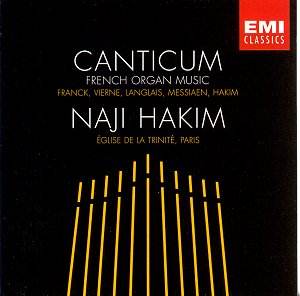The most remarkable feature of this ’debut’ EMI recording
is the ideal match of the selected performed pieces with the Cavaillé-Coll
organ of La Trinité. Another remarkable feature is the various
links between the composers, who contribute, each one separately, to
the tradition of French organ music.
Almost a century and a half of French organ music is
explored in this CD, beginning with César Franck. Franck
served as organist at the Basilica of Saint Clotilde and it was at his
advice that the new Cavaillé-Coll organ was installed there in
1859. He also helped with the installation of other Cavaillé-Coll
organs, including that of La Trinité. His Choral in A min
(1890) is ‘related in form to Liszt’s one movement sonata’, as the
booklet inform us, whereas the Cantabile (1878) is an expressive
poem that reveals the romantic character of the French symphonic organ.
Louis Vierne, who was a pupil of Franck, served
as an organist in Notre Dame, where Cavaillé-Coll also installed
one of his organs. The Pièces de Fantaisie explore the
colours of the Cavaillé-Coll and captivate the listener with
the simplicity of their form and the beauty of their melodies.
Three generations after Franck, Jean Langlais was
appointed organist at Saint Clotilde in 1945. He was influenced by this
organ, which he called his ‘mistress’. The performed Pieces (1935)
are based on the plainchants that he loved so much and they are, by
turns, tonal and modal. They are also rich in harmonic and contrapuntal
means.
Messiaen, who was a schoolmate and a friend
of Langlais, followed a different compositional path, developing his
own modal system. His compositions were influenced usually by religious
themes and unfolded an irregular rhythmic system. Dieu parmi nous
is the last piece of the cycle La Nativité du Seigneur (The
Nativity of our Lord - 1935). It is one of the most well known pieces,
dealing with three themes before the final blasting toccata on the initial
theme. Prière après la communion is a ‘melodic
garland’, on two keyboards, from Messiaen’s last organ work, the Livre
du Saint Sacrement (1984).
Naji Hakim, a student of Langlais and successor
of Messiaen at La Trinité in 1993, is ‘the most important representative
in the last twenty years of the great French tradition of organist-composer-improviser’.
Canticum Suite is a paraphrase of the hymn Conditor alme siderum,
the chant Rorate coeli desuper and the anthem O Emmanuel.
It presents sharp, virtuosic rhythmic figures. Pange Lingua is
a set of variations based on the chant with the same name. A very charming
piece indeed.
The Cavaillé-Coll organ of La Trinité
was completed in 1868. Much of its present aesthetic direction is owed
to Messiaen, who asked, while organist there, for the addition of a
‘spectrum of harmonic timbres: mutations, mixtures and reeds, which
enabled new means of expression to be explored’.
In this CD Hakim, the organist, succeeds only occasionally
in capturing the spirit of the music. The performances of the Franck’s
pieces lack a legato line, resulting in a dry, cold effect. Also the
sharp cuttings of phrases where more time and weight is needed rather
spoil the balance of the melodies. On the other hand, in Messiaen’s
pieces he gives a very flowing legato line, with the appropriate rhythmic
sharpness and punctuality that characterizes his playing generally.
Vierne’s pieces are performed with sensitivity and accuracy, although
they tend to be sometimes too metronomic. The Langlais performances
are the least persuasive. They lack poise and a good control of the
different tempi. As for the Hakim pieces, who would know better than
the composer himself, how his pieces should go?
Christina Antoniadou


